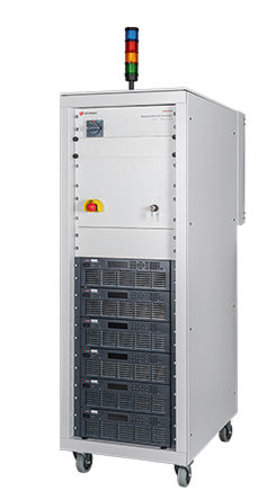Keysight SL1200A Series Scienlab Regenerative 3?Phase AC Emulator
Highlights
The SL1200A series was designed to handle all your 3-phase AC test needs up to 1200 VAC, from 30 to 630 kVA without the need for a transformer. Two voltage ranges are available: 600 and 1200 VAC. The 600 VAC models are ideal for low voltage inverter test as well as EV and EVSE charging test applications. The 1200 VAC models allow for (HVRT) testing at the IEC LV-AC limit without the need for a large, complex test setup.
Key Features:
- Covers AC test needs; up to 1200 VL-L; up to 130 A; up to 630 kVA
- Achieve 1200 VL-L at full specifications without extra equipment, such as a transformer
- Save energy with 100% regenerative (bidirectional) power solution with > 85% efficiency
- Get up and running immediately with intuitive soft front panel (SFP)
- Feel confident with complete, one-vendor solution of hardware, software, consulting, and support services worldwide for many applications, such as EVSE / EV charging test
Today’s energy/grid infrastructure is changing and growing rapidly. Variable renewable energy (VRE) and inverter-based distributed energy resources (DERs) in the form of solar, wind, and battery storage are the dominant theme in global grid modernization initiatives. Within the automotive industry, the electrification of vehicles is expected to create significant demand on the grid for charging, while also expanding the opportunity for energy storage through vehicle-to-grid (V2G) power applications.
As the energy mix intensifies, so does the challenge of managing the way we produce, distribute, and consume electricity. “Smart” inverters with grid support functionality have emerged as a key enabler to overcoming such challenges. As a result, inverter manufacturers are required to adhere to a specific set of grid compliance/interconnection standards that necessitate the need for extensive test. To test, grid emulation equipment is required.
DERs are also moving to higher output voltages to reduce losses and costs, moving from 600 to 800 VAC, and potentially up to 1000 VAC in the future (IEC-LV directive allows up to 1000 VAC). The goal of higher voltages combined with the requirement to provide grid support functions, such as high-voltage ride-through (HVRT), creates the need to test to even higher than the 1000 VAC limit.
To achieve the high voltages needed to test new inverter/control designs, inverter engineers often must either connect multiple power supplies in series or use an external transformer. This leads to costly, complex test setups with an inability to easily expand, along with reduced performance, wasted space, and other additional downsides.
Today’s energy/grid infrastructure is changing and growing rapidly. Variable renewable energy (VRE) and inverter-based distributed energy resources (DERs) in the form of solar, wind, and battery storage are the dominant theme in global grid modernization initiatives. Within the automotive industry, the electrification of vehicles is expected to create significant demand on the grid for charging, while also expanding the opportunity for energy storage through vehicle-to-grid (V2G) power applications.
As the energy mix intensifies, so does the challenge of managing the way we produce, distribute, and consume electricity. “Smart” inverters with grid support functionality have emerged as a key enabler to overcoming such challenges. As a result, inverter manufacturers are required to adhere to a specific set of grid compliance/interconnection standards that necessitate the need for extensive test. To test, grid emulation equipment is required.
DERs are also moving to higher output voltages to reduce losses and costs, moving from 600 to 800 VAC, and potentially up to 1000 VAC in the future (IEC-LV directive allows up to 1000 VAC). The goal of higher voltages combined with the requirement to provide grid support functions, such as high-voltage ride-through (HVRT), creates the need to test to even higher than the 1000 VAC limit.
To achieve the high voltages needed to test new inverter/control designs, inverter engineers often must either connect multiple power supplies in series or use an external transformer. This leads to costly, complex test setups with an inability to easily expand, along with reduced performance, wasted space, and other additional downsides.


